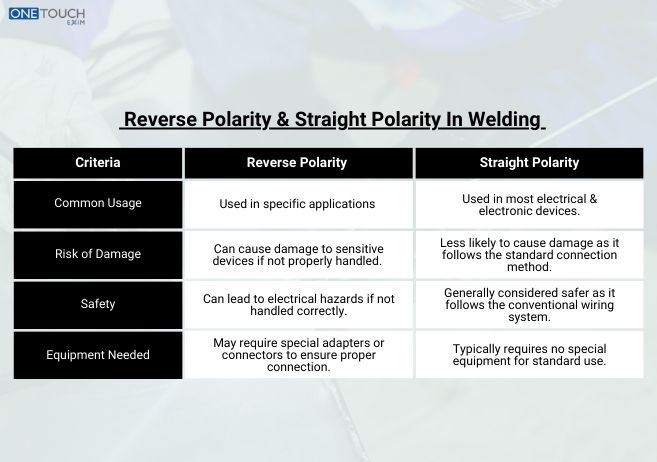In Welding, polarity refers to the direction of electrical current flow. D/C Straight (DCEN) is when the electrode is negative and the workpiece is positive. This offers higher penetration and faster deposition and is particularly suitable for thicker metals. Reverse polarity (DCEP); Power flows from the electrode back to circuit to the workpiece creating a shallower and wider bead profile with good cleaning action, beneficial on thin metals, as well as removing oxides. Ac welds the two polarities together, for materials such as aluminium. The correct polarity is chosen for each case to achieve the best weld quality, arc stability and efficiency for the material and electrode type and the type of welding to be performed.
When to Use Reverse or Straight Polarity
In welding, straight polarity is employed for deep penetration as it focuses the heat on the workpiece. Eg-steel. It is compatible with SMAW and TIG Welding applications of some metal components.
DCEP – That is Direct Current Electrode Positive – it puts more heat on the electrode, delivering better cleaning action and a wider flatter weld bead. It’s best for thin metals, aluminium and coated electrodes such as E6010.
Alternating Current (AC) combines them, typically in aluminium to TIG welding. Determine polarity according to material thickness, types of electrode and desired welding characteristics.
How Does Polarity in Welding Work?
Welding polarity defines the direction of electric current flow between the electrode and the workpiece. Direct Current, Electrode Negative (DCEN) – DCEN works best for thinner metals, the electrode is negative and the workpiece is positive, giving 70% heat to base metal for shallower penetration – best for thinner metals. In Direct Current Electropositive (DCEP), the electrode is positive, with 70% of heat centred around the electrode, induces a clean, wide weld with any less penetration, good with thin metals and removes oxide. AC alternating current switches between both, best for materials like aluminium. Selecting the appropriate polarity helps to provide proper arc stability, penetration and quality of weld for respective material and electrode types.
Why Is Polarity Important in Welding?
Polarity plays a very important role in welding as in DCEN (Straight Polarity), the heat focuses on the work, allowing the penetration deeper in thicker metals. In case of DCEP (Reverse Polarity), the heat will be more concentrated at the electrode, resulting in better cleaning action (oxide removal) and shallow, wide weld bead profiles for thin materials. Off Polarity can cause unstable arc,weak welds or excessive spatter. AC polarity neutralizes both effects, which it good for aluminium and magnesium. The Selection of polarity will also give GER260 or MILLER240 maximum performance, efficiency and clean, defect free weld, which suit the electrode type, material thickness and required well properties.
AC Welding and DC Welding
AC (alternating current) welding: The type of current which changes direction several times per second (50-60 HZ) and is particularly suitable for welding aluminium and magnesium because of its oxide-cleaning action. This allows moderate penetration and a steady arc, ideal for thick metals and overhead welding. Though it may not offer the consistent arcs DC is able to provide.
DC welding (direct current) is the more predictable flow and provides less splatter, better control and penetration as well as more smooth, stable arc which is ideal for general fabrication work. DCEN (electrode positive) ensures cleaning action for thin materials. TIG, Stick and MIG use similar techniques above but DC is preferred for precision welding and you need to choose the correct polarity.
Understanding the Different Types of Polarity
The direction of flow of electrical current or welding polarity is a very important factor influencing the quality of a weld. Direct Current Electrode Negative provides approx 70% of the heat to the part, allowing for deep penetration of up to 2 or 3 times the thickness of the material. DC Electrode Positive (DCEP) reverses (spinning in opposite direction) of this flow, directing 70% of the heat to the electrode (offering good cleaning action, ideal for thin metals that can’t take a lot of heat). AC (Alternating Current) uses both polarities, reversing directions routinely – good for aluminium and magnesium, since it helps chip away at the oxides on their surface. Proper Polarity which Aids in Best Arc Stability, Penetration and weld Quality is essential for most TIG Applications and is the final step in achieving both purpose and function.
How to choose the correct polarity
The appropriate welding polarity is determined based on the type of material, thickness and the electrode/wire used. When deep penetration is required in thick metals. Use DCEN (Straight polarity) which provides a higher concentration of heat to the work piece. With Thin Metals or if you are using a cellulose electrode (E6010), choose to go with DCEP (Reverse Polarity) as it’ll clean better and provide more controllable heat. AC Polarity is Excellent for Aluminium and Magnesium by combining both Cleaning and Penetrating. Always check the electrode manufacturers instructions – some rods (such as E7018) can be used with both polarities. Just so long as the proper polarity is maintained you will have stable arcs, strong looking welds, and fast and efficient metal deposition.
Conclusion
In welding, polarity has essentially the effect on heat distribution between the electrode and workpiece. DCEN (Direct Current Electrode Negative) offers deeper penetration and is great for welding thick materials. In contrast, Direct Current Electrode Positive (DCEP) provides quicker melting of the electrodes and superior cleaning action of oxides, making it the choice for thinner materials and specific electrodes. Accordingly the proper polarity is not an optional consideration, but rather a critical aspect, in order to obtain optimum arc stability, weld integrity and overall joint quality in the end product.
